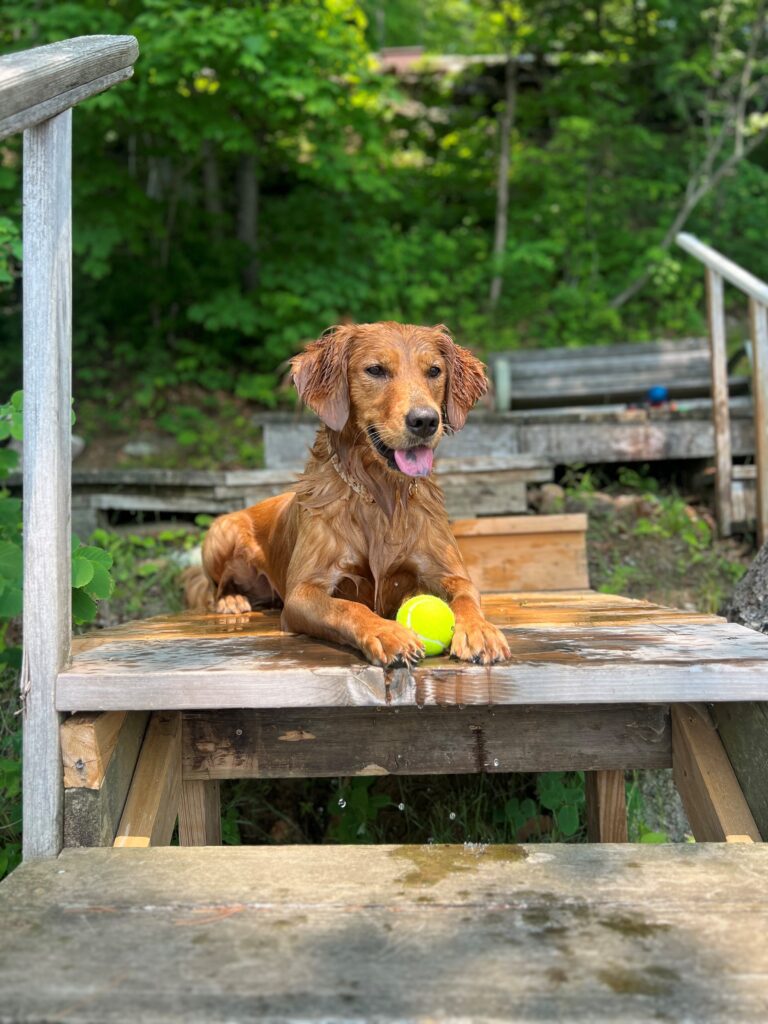
Give Your Heart To A Golden
GoldHeart and Its Network of Volunteers is Dedicated to the Rescue of Golden Retrievers in Need


History
GoldHeart was started in 1999 by a small, dedicated group of volunteers with an undying love for Golden Retrievers. The initial group of volunteers was members of the Golden Retriever Rescue Education and Training (GRREAT), complementing GRREAT’s efforts by concentrating GoldHeart’s mission in Maryland, south-central Pennsylvania, and Delaware areas.
GoldHeart’s first priority continues to be rescuing and placing Golden Retrievers and golden mixes located within our service area. We will also consider helping Golden and golden mixes in other areas of the country if resources permit.
When we are asked to rescue a needy Golden Retriever outside of our country, GoldHeart may consider these dogs consistent with our organization’s intake priorities and, again, available resources.
Since 1999, GoldHeart volunteers have successfully placed over 1260 dogs in forever homes, GoldHeart’s membership has also grown to over 500 members/supporters, who we could not exist without their support. We typically take in from 30-40 goldens and golden mixes per year, and receive between 75-100 new applications to adopt annually.
Absent any major changes in a home, an application approval is generally good for three years from date of issuance. The bulk of the day-to-day rescue efforts are handled by the all-volunteer Board of Directors and a dozen or so core volunteers.

Mission
GoldHeart, Golden Retriever Rescue, and its network of volunteers are dedicated to the rescue of unwanted, abused, neglected, and displaced Golden Retrievers. We provide Goldens in need with a temporary safe haven in our foster homes where they receive love, food, grooming, medical treatment, and some training. During this time, their temperament is evaluated to determine the best home for their personalities, and ultimately they are relocated to loving adoptive “forever” homes.
GoldHeart volunteers work to foster a public sentiment of humanity and gentleness toward Golden Retrievers and all other animals. They encourage and promote responsible pet ownership, do all within their power to reduce pet overpopulation, and will work to encourage humane treatment and care of animals through education and spay/neuter advocacy.
GoldHeart Service Area
GoldHeart routinely services most of Maryland, south-central Pennsylvania, and Delaware. We are a small all-volunteer rescue group that takes in about 30-40 goldens and golden mixes per year and typically receives between 75-100 new applications to adopt annually. Absent any major changes in a home; an application approval is generally good for three years from the date of issuance.
Specific counties we service are in the coverage map. If you live outside these areas, please DO NOT APPLY. You may find another Golden Retriever rescue online; and here is one site that lists rescues by state.

FAQs
There are a number of reasons to adopt a rescued Golden.
The dogs that come into GoldHeart come from many different sources.
There are many reasons people give for surrendering their dog. The top reasons we hear are:
Rarely are behavioral problems an issue with a dog that comes into rescue. If a behavioral problem is encountered, we try to deal with them before the dog is adopted. Our dogs usually spend a minimum of two weeks in an experienced foster home, where their personality and behavior are observed and evaluated. We have an excellent dog trainer/dog behaviorist that works with us whenever needed.
Dogs never lose their ability to learn. In many cases, the older dogs learn more quickly than the ones still in the puppy stages because they are better able to focus.
There is little difference in the temperament of male and female Goldens. Both sexes are equally easy to house train, equally intelligent and affectionate. Both are excellent with children, and both make excellent companions. Some males are inclined to mark their territory, but this can also be exhibited by dominant females. On average, the younger males tend to be more active than their female counterparts, but there are some very active females.
Golden Retrievers are wonderful family dogs, however any dog owner needs to be aware of a few simple precautions.
If properly introduced and used judiciously, a crate will become the dog’s den.
Golden Retrievers are typically very easygoing dogs that get along with other dogs very well. Cats can be a different story. Some Goldens have very high prey drives that will cause them to chase things that run. If a Golden hasn’t lived with cats, they should be cautiously introduced to cats to see their reaction. The same would be suggested for other small furry animals and birds in the home.


Meet Augie – she is the oldest known Golden Retriever, pictured here celebrating her 20th Birthday! Augie was born April 24, 2000, and after being re-homed twice (due to no fault of her own), landed with Jennifer and Steve Hetterscheidt of Oakland, Tennessee. Jennifer and Steve, who were active in their local golden retriever rescue organization when they got Augie, adopted her when she was 14 years old. Augie reminds us that age is only a number and that there is nothing as special as Old Gold. Augie left her loving family on March 23, 2021, at 20 years and 11 months old. Jennifer told GoldHeart….”Steve and I lost many goldens throughout the years. One thing I know: Love and care for them while we have them and love them forever.” RIP, beautiful girl.
Source: The Hettersheidt family and https://goldenhearts.co/oldest-golden-retriever/.
Yes, this is an anomaly, but with better diets, exercise, and regular veterinary care, goldens are routinely living from 12 to 14 years of age and many well beyond that. One recent GoldHeart rescue #830, Teddy, passed his 17th birthday after coming into GoldHeart at age 12.
Dogs are susceptible to many of the disease that humans contract. The health issues which most commonly afflict Goldens are:
Yes. Goldens are big shedders since they have double coats. Brushing often will help you keep shedding under control. You should NEVER shave your golden. They need their double coat to protect them year-round. It keeps them cool in the summer and protects them from the sun, bugs and other issues. Goldens have a tendency to get ear infections, so it’s important to have their ears checked and cleaned regularly. Try to keep the hair around the feet and pads trimmed up and trim nails on a regular basis. With this double coated breed, regular baths and proper drying also sets the foundation to maintaining healthy skin and coat, so your golden will benefit from routine professional grooming.
This is entirely dependent on the dog. Some dogs have very high energy levels, and they require several hours of exercise a day. Others are very laid back and get by with just walks. If your lifestyle does not allow time for exercise, opt for a calmer, easy-going dog.
A standard well-bred Golden Retriever male will stand 22″-25″ high at the shoulder and weigh between 65-75 lbs. Females stand 20″-23″ at the shoulder and weigh between 55-65 lbs. Because of indiscriminate breeding, we see Golden Retrievers that are much larger and weigh in excess of 100 lbs.
The places you can purchase a puppy from are many, but you would be wise to get a puppy from a responsible breeder.
Contact a local Golden Retriever Club in your area and ask for recommendations. Two clubs in this area are the Potomac Valley Golden Retriever Club and Chesapeake Golden Retriever Club. Another source is the Golden Retriever Club of America.
No! No! No! There is not a responsible breeder that would ever consider selling puppies to a pet store. They get their puppies from “puppy mills.”
The advertisements in the papers are placed there by puppy mills and backyard breeders. The puppy mill breeder should be avoided at all costs. The backyard breeders are probably your best bet if you are not going to go to a responsible breeder. If you purchase from a backyard breeder, meet the puppy’s mom and dad, make sure they have no physical problems (get permission to check with their vet), make sure it is a clean/healthy environment, and determine the age of the mom and how many litters she has had (a dog should not be bred until she is at least 2 years old), make sure the puppies have been to see a vet and are up-to-date on shots. If the seller refuses you any of this information, walk away. The 1st 8 weeks of a puppy’s life are more important than most people realize. A puppy should never be separated from the litter until it is at least 8 weeks of age. To see just home terrible puppy mills can be, visit http://www.humanesociety.org/issues/puppy_mills/.
Responsible breeders never have more than one litter a year from a female. They do not breed a female until it is at least 2 years of age. They know the lineage of their dogs for many generations. They never breed dogs that have any medical issues that could be passed on to the puppies. They have the puppies extensively checked over by their veterinarian and provide general health certifications. They provide a healthy, rich environment for the puppies until they go to their new homes. They will always take one of their dogs back if it needs to be surrendered by the owner. They screen the new owners and the puppies for a temperament match. This is often a situation of “pay me now or pay me later.” The probability of a well-bred, well-socialized puppy having medical or behavioral problems is significantly reduced. In spite of the price they charge, they are not in it for the money. They do it for the love of the breed and the desire to perpetuate the breed as it should be.
Golden Retrievers are the second most popular AKC breed. The only breed more popular is the Labrador Retriever. Well-bred Golden Retriever litters are in high demand. The responsible breeders will have a waiting list for their puppies, but most will be happy to talk with you about any upcoming litters.
Working should not prohibit you from raising a puppy. However, a puppy does demand extra time and attention, and you will need to make provisions to care for your puppy. Caring for a puppy brings responsibilities and obligations that need to be considered. A puppy turns into a dog, and a Golden will eventually grow to be between 65-80 lbs. and stand 21-26″ high. This dog will need to be cared for on a daily basis for the next 10-16 years and will become a family member (living/breathing), not an item or thing that is disposable. A puppy needs the following:
Working should not prohibit you from raising a puppy. However, a puppy does demand extra time and attention, and you will need to make provisions to care for your puppy. Caring for a puppy brings responsibilities and obligations that need to be considered. A puppy turns into a dog, and a Golden will eventually grow to be between 65-80 lbs. and stand 21-26″ high. This dog will need to be cared for on a daily basis for the next 10-16 years and will become a family member (living/breathing), not an item or thing that is disposable. A puppy needs the following:
